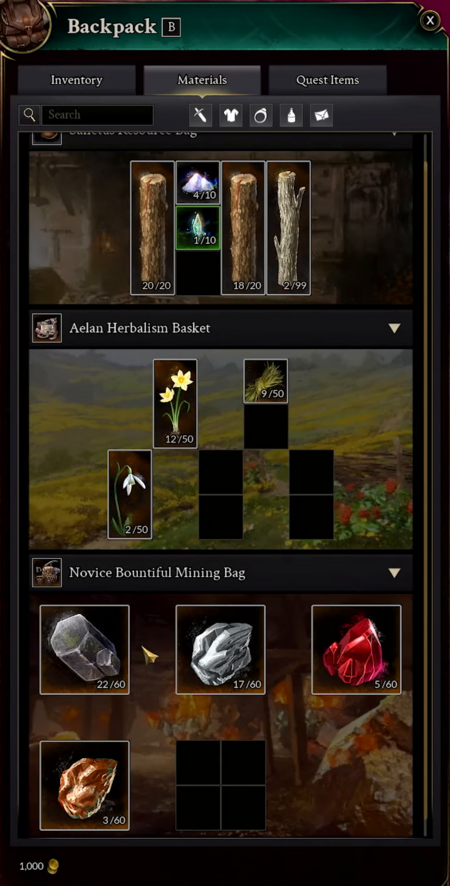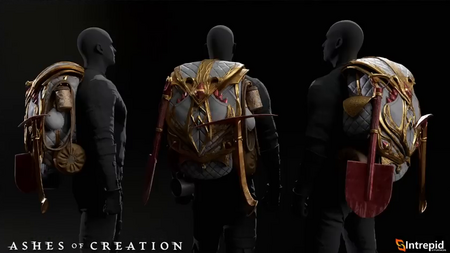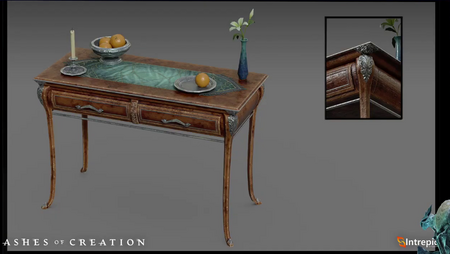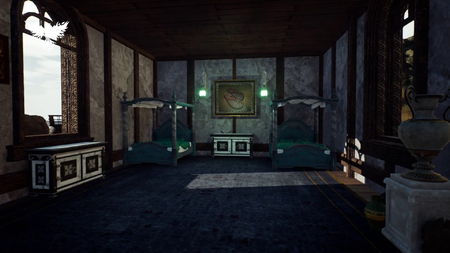Chests
Chests are a type of furniture that provides localized storage within a specific house.[2][3][4]
- Players must obtain and place storage containers in their player-owned housing.[3]
- Different grades of storage containers have different inventory capacities.[3]
- There are restrictions on the grades of storage containers available in different types of houses.[3]
- Access permissions can be set to allow others to access a player's personal storage devices.[2][5][6][7]
- Personal storage chests may be set to permit access by family or guild members.[6][8]
- Transfer of resources and materials to alts will only be possible via player housing storage, as this is local to the specific house.[2]
- Players are prohibited from moving goods out of depositories within a node following a siege declaration against that node.[9]
- Gatherables and crafting materials that were stored in in-node housing and apartment storage chests become lootable upon a successful siege against the parent node. These do not become lootable if the node survives the siege- even if the housing buildings are destroyed or damaged during the siege.[10]
- Corrupt players are not able to utilize storage systems.[11][12][13]
- Personal caravans may be launched from any point of storage (including chests).[14]
Warehouses
Storage points exist at warehouses within nodes and in chests (storage containers) that can be placed in freeholds and static in-node housing.[15][16][17]
- Sheds are present on empty freehold plots to provide basic storage for materials needed to construct freehold buildings.[18]
Household security
A permissions system will enable an owner/primary tenant to grant access to specific parts of their housing.[19][20][6][21]
- Ability to open the door and enter the home.[5][6][21]
- Access to crops.[22][6]
- Ability to deposit or withdraw items from storage containers.[2][5][6][7][8]
- Permission to use furniture or crafting stations.[5]
A property has a single owner/primary tenant.[19][23][20]
- Marriage enables family size to increase by one so that housing access can be shared.[23][24]
- Access lists can be used to mimic co-ownership.[21]
- Payment of taxes may be via a "gentleman's agreement".[25]
- It'll be a single owner based system for those types of properties- for properties in general, but it doesn't prevent players obviously from collaborating and pooling resources in order to achieve certain achievements in the game.[20] – Steven Sharif
Carpentry
Carpentry (furniture making) is a Crafting profession in Ashes of Creation.[27][28][29][4]
- Quality furniture is able to be crafted in-game based on the skill of the craftsperson.[4]
- Grandmaster carpenters can craft a number of items, including furniture, weapons, siege equipment, and ship components.[30][31]
- Components of unique furniture recipes will be drops. The rarity of these items will scale based on the power it confers to the specific type of furniture it constructs.[32]
- Furnishing items with in-game functionality will be restricted entirely to those created by the carpentry profession.[28]
- Crafted furniture may contain bonuses based on the quality and grade of the furniture.[33]
- Your ability to craft more luxurious furniture comes with how much of a master craftsman you become in the Furnishing profession.[4] – Steven Sharif
Housing decorations
Players may decorate their player housing and other types of buildings.[37]
- Houses will be empty when purchased.[38]
- Players may be able to upgrade to pre-furnished sets when they purchase their home.[28]
- Pre-furnished sets will be almost entirely visual and aesthetic. Only items crafted by the Carpentry profession will have in-game functionality.[28]
- Players may place furniture, artwork/paintings and other decor items in their player housing.[39][40][3][41][42]
- Items may only be placed in locations that are suitable for that item. For example: Statues, may only be placed in exterior locations (of Freeholds and Static housing).[28]
- Each size, grade, and type of player-owned housing determines the number and type of items that can be placed in it.[39][43][44] For example: You can place only the best furniture in mansion grade in-node housing.[39]
- Building skins may change the shape of a homestead but the space available for furnishings should remain consistent.[43]
- When it comes to if you put a cosmetic house on top of your normal house, those cosmetics should be similar in size. The shape will change, so maybe the room layout will be different, but it'll still be like a one-story building.[43] – Margaret Krohn
- Characters will be able to interact with furniture items such as sit in chairs and lay in beds.[45]
- Players will not be able to alter structural aspects such as windows and walls.[28]
- There may be decor items that are representative of unique weapons that are available in the game.[46]
Quality furniture can be crafted in-game based on the skill of the craftsperson and availability of recipes, components and workbenches suitable to craft them.[39][4]
- Furnishing items with in-game functionality will be restricted entirely to those created by the Carpentry profession.[28]
- Your ability to craft more luxurious furniture comes with how much of a master craftsman you've become in the furnishing profession... This isn't like , I want my house to look good, I got to fork over 50 bucks in cosmetics... Players can craft in-game based on their dedication and focus in that aspect the artisan tree.[4] – Steven Sharif
- Prized items such as achievements and trophies may be displayed.[47]
Player inventory

Inventory for A2 will exist in two categories, spatial and non-spatial. The spatial inventory system will only exist for materials and gatherables. The non-spatial system will be the normal single slot inventory that is used for all completed items IE gear, consumables etc.. The spatial system is intended to provide limitation and progression when everything in the open world is gatherable, requiring players to strategize which things they choose to gather or not. These spatial inventories will be shaped in various ways that make the bag types more conducive for certain types of gatherables allowing players to specialize their capacity. Auto sort is a feature[49] – Steven Sharif
Inventory capacity has quantity (stacking) limits based on the type of item.[50][51] Backpacks offer varying stack sizes and/or spatial inventory shapes that are optimized for carrying different items.[52][53]
- A player's inventory has sections for different types of items.[54] Quest items for example will not fill a player's regular inventory capacity.[55]
- Materials and resource bags have spatial ("Tetris" style) slots for items with different shapes and sizes.[56][49][57][58][59]
- The spatial inventory system is intended to mitigate the potential for players to diminish land management scores by stripping resources from particular zones as well as provide a challenging gameplay layer for players.[56][60]
- Inventory is split into two separate management systems. The first is your non-material, non-gatherable slots. Those are your standard single slot, not-space-constrained system that's a standard inventory: you just have a single slot, and you can pull completed items and/or consumables and quest items or whatever into that slot. And then, when you're talking about materials, specifically processed goods and gatherables: those exist within the Tetris type uh inventory system.[57] – Steven Sharif
- All those materials actually sorted nicely in the appropriate bags based on your stack sizes.[48] – Alex Khudoliy
- There will be a healthy number of slots for gear in a player's inventory.[61]
- Completed item inventory slots are not space constrained (by the tetris system).[57]
- Completed items, such as gear are also not subject to weight limits.[61]
- Gear loadouts can be swapped using a hotkey when out of combat.[61][62][63]
- Inventory capacity will be relatively limited for new characters.[55] Additional capacity may be increased by obtaining higher quality backpacks from crafters.[64][57][50]
- We want to have very unique progression when it comes to the construction of resource bags; and those resource bags will have certain benefits, like increasing stack size count of particular types of resources; or of having a additional delay time necessary to interface with with your corpse, should a player try to take the resources you might have dropped in PvP; or having passive benefits and unique structures of spacing that makes it more a better bag for wood gathering because woods are three-by-one; or a better bag for mining because mining is always two-by-two. The idea is to make your intent as a gatherer when you go out into the wild specific right not just that you're going out into the wild and gathering everything you can because it's there; and that's what we don't have like a labor system that limits it. We have a space constraint system so when you leave your node and you go out into the wild you need to be conscientious of what you're choosing to interact with and take resources for, because you have a limited space constraint to that degree.[57] – Steven Sharif
- Inventory capacity is subject to quantity rather than weight limits.[50]
- In my opinion, and this is of course subjective, but weight management is not a compelling mechanic for players to have to deal with in an MMO setting.[50] – Steven Sharif
- Players will have the ability to search for items they have stored in various locations (such as personal storage and node warehouses).[65]
- We want you to know where the things are; and then the meaningful aspect of that thing is traveling to those locations to access some of those things, particularly as it relates to materials and raw gatherables.[65] – Steven Sharif
- Inventories will be able to be sorted.[49]
- Q: Why did you go for a spatial inventory system for resources?
- A: There's a number of different methods that we can use in an effort to mitigate, or again throttle, the amount of success that players can have in any one trip out in the world. Now, we're using a combination of three things: We are using progression gating through your profession level; so you need to have a certain level to access certain resources. We are utilizing the spatial inventory space as a limitation on how much things you can gather before you need to go back to town. And then lastly we have a tool predicate where you need to have a tool that is relevant for the resource you're gathering; and those tools have a decay value after each use. Weight is obviously an approach that we could take if we wanted to limit. However, the spatial system works in concert with a number of other types of systems. For example, we want to have itemization drop on death specifically as it relates to material items; and we want there to be an additional layer above just weight that introduces complexity; and where there is complexity there is choice and there is strategy and there is planning required on behalf of the player in order to set themselves up for the best possible success in certain situations.[56] – Steven Sharif
- Mules can carry roughly 10 times more than backpacks. Caravans can carry roughly 10 times more than mules.[66]
- Inventory expansion and weight management training certificates are available in the Galleria at City stage economic nodes.[55][67]
Backpacks

I see now I've actually gotten a unique looking structure for the Aelan Herbalism Basket; and those are the types of structures you would expect them to gather that are the gatherables for herbalism. So, that's not necessarily to say that I can't collect non-herbalism resources: I could and I could put them in that bag, but it just wouldn't utilize the most beneficial aspect of it, which is the higher stack count for those types of herbalism resources.[52] – Steven Sharif

In order to roleplay you need to be able to represent what your character is doing in that world and part of what animation is doing is creating these sockets on the let's say the belt or the backpack that can plug in certain types of props or items that are created by the character team.[69] – Steven Sharif
Backpacks (also referred to as a Bags) are craftable items that provide personal inventory space.[64][57][70][53][50]
- Backpacks offer varying stack sizes and/or spatial inventory shapes that are optimized for carrying different items.[52][53]
- Gatherer's backpacks are intended to carry gatherable resources in spatial inventory slots relating to specific gathering professions.[52][53]
- Adventurer's backpacks are intended to carry consumables and items in non-spatial inventory slots.[53]
- These bags have specifically curated benefits for stack sizes of the type of resources they relate to and that's the specific profession of gathering and the resources you would gain from those those different unique professions.[52] – Steven Sharif
- Profession NPCs sell lower level backpacks.[71] Higher level backpacks are crafted by players.[64][57][70][53]
- There's item progression as it relates to quality of bags, types of bags, and the materials they're most used for. Some of them are more PvP oriented that can reduce significantly drop rates for PvP as a result of that progression.[70] – Steven Sharif
- Artisans must meet the required artisan certification to equip backpacks of that level (or lower).[72]
- A character currently may equip up to 3 artisan backpacks, but is subject to change.[73]
- Backpacks are equippable (visually) in a character's back slot.[68][76]
- Backpacks are only able to be equipped by player characters.[77]
- Some backpack types may have additional stats on them.[78]
- Some of those bags might have increased times to interact with a player corpse and you can choose to perhaps have less capacity, less stack size, less slot availability for the certain types of gatherables you may want to acquire in exchange for an increased interaction time for other players that might try to loot that bag, giving you time to reach it and take back your belongings. Or, if in the middle of a fight they see a corpse on the ground and they're like wait a minute, I want to grab that. Well, if I got to spend 10 seconds to interact with that corpse and there's combat going on, this is an opportunity strategically for you to recapture the grounds- for you to recapture the battlefield. You want to think about those types of interactions. How do you add layers of strategy to engagements and and there's ways to do that through inventory management as well.[79] – Steven Sharif
Visuals
2023-07-02 2023-07-01
See also
References
- ↑ 1.0 1.1 Livestream, June 25, 2021 (22:34).
- ↑ 2.0 2.1 2.2 2.3 Livestream, July 30, 2021 (1:14:33).
- ↑ 3.0 3.1 3.2 3.3 3.4 Video, May 31, 2020 (47:32).
- ↑ 4.0 4.1 4.2 4.3 4.4 4.5 Livestream, August 17, 2018 (10:54).
- ↑ 5.0 5.1 5.2 5.3 Livestream, April 30, 2021 (1:12:33).
- ↑ 6.0 6.1 6.2 6.3 6.4 6.5 Livestream, June 26, 2020 (51:58).
- ↑ 7.0 7.1 Livestream, June 28, 2019 (1:23:31).
- ↑ 8.0 8.1

- ↑ Livestream, April 30, 2020 (1:14:44).
- ↑ Interview, July 8, 2020 (57:46).
- ↑ Livestream, February 24, 2023 (1:12:24).
- ↑ Livestream, October 28, 2022 (24:28).
- ↑ Livestream, April 30, 2021 (1:14:49).
- ↑

- ↑ 15.0 15.1 Video, June 30, 2023 (19:20).
- ↑ Interview, December 6, 2018 (20:30).
- ↑ Video, May 31, 2020 (47:32).
- ↑ Livestream, June 30, 2023 (18:45).
- ↑ 19.0 19.1 Livestream, August 31, 2023 (22:32).
- ↑ 20.0 20.1 20.2 Livestream, June 26, 2020 (58:32).
- ↑ 21.0 21.1 21.2 Livestream, May 19, 2017 (26:40).
- ↑ Livestream, June 30, 2023 (1:19:01).
- ↑ 23.0 23.1 Livestream, June 30, 2023 (1:24:16).
- ↑ Livestream, January 29, 2021 (1:13:04).
- ↑ Livestream, February 9, 2018 (51:57).
- ↑ Livestream, December 23, 2021 (1:16:26).
- ↑ Livestream, October 14, 2022 (32:38).
- ↑ 28.0 28.1 28.2 28.3 28.4 28.5 28.6 Interview, July 8, 2020 (40:20).
- ↑ Livestream, May 29, 2020 (40:52).
- ↑ Podcast, December 3, 2023 (9:40).
- ↑ Podcast, December 3, 2023 (8:47).
- ↑ Livestream, June 30, 2023 (1:23:49).
- ↑ 33.0 33.1 Interview, July 8, 2020 (43:42).
- ↑ Livestream, July 25, 2020 (1:01:07).
- ↑ Livestream, May 29, 2020 (36:18).
- ↑ Video, June 30, 2023 (10:24).
- ↑ Livestream, November 17, 2017 (26:22).
- ↑ Livestream, June 26, 2020 (53:20).
- ↑ 39.0 39.1 39.2 39.3 Livestream, January 27, 2023 (1:35:45).
- ↑ Livestream, June 26, 2020 (45:32).
- ↑ Livestream, May 24, 2017 (29:54).
- ↑ Livestream, May 29, 2020 (38:04).
- ↑ 43.0 43.1 43.2 Livestream, January 28, 2022 (1:13:55).
- ↑ Livestream, June 26, 2020 (47:32).
- ↑ Livestream, May 22, 2017 (56:31).
- ↑ Livestream, June 25, 2021 (1:31:04).
- ↑ Livestream, May 10, 2017 (30:53).
- ↑ 48.0 48.1 48.2 Video, November 30, 2023 (30:19).
- ↑ 49.0 49.1 49.2 Twitter - Steven Sharif - Spatial inventory slots.
- ↑ 50.0 50.1 50.2 50.3 50.4 Livestream, February 24, 2023 (54:55).
- ↑ Livestream, May 29, 2020 (1:27:18).
- ↑ 52.0 52.1 52.2 52.3 52.4 52.5 Video, November 30, 2023 (13:38).
- ↑ 53.0 53.1 53.2 53.3 53.4 53.5 53.6

- ↑ Livestream, February 24, 2023 (22:57).
- ↑ 55.0 55.1 55.2 Livestream, July 25, 2020 (1:14:13).
- ↑ 56.0 56.1 56.2 Livestream, November 30, 2023 (1:29:18).
- ↑ 57.0 57.1 57.2 57.3 57.4 57.5 57.6 Livestream, June 30, 2023 (1:24:42).
- ↑ Livestream, June 30, 2023 (46:17).
- ↑ Video, June 30, 2023 (8:54).
- ↑ Podcast, July 15, 2023 (22:57).
- ↑ 61.0 61.1 61.2 Interview, September 10, 2023 (47:13).
- ↑ Livestream, February 24, 2023 (46:15).
- ↑ Livestream, November 19, 2021 (40:53).
- ↑ 64.0 64.1 64.2 Livestream, November 30, 2023 (1:34:08).
- ↑ 65.0 65.1 Livestream, July 29, 2022 (1:17:33).
- ↑ Livestream, July 18, 2017 (44:57).
- ↑ Know Your Nodes: Economic Node Type.
- ↑ 68.0 68.1 Livestream, April 28, 2023 (1:08:55).
- ↑ Livestream, May 30, 2019 (1:09:17).
- ↑ 70.0 70.1 70.2 70.3 70.4 Livestream, April 28, 2023 (1:18:48).
- ↑ Video, November 30, 2023 (12:05).
- ↑ Podcast, December 3, 2023 (13:00).
- ↑ Podcast, December 3, 2023 (3:11).
- ↑ Livestream, November 30, 2023 (1:43:53).
- ↑ Podcast, December 3, 2023 (14:12).
- ↑

- ↑ Livestream, November 30, 2023 (1:44:04).
- ↑ Podcast, December 3, 2023 (14:18).
- ↑ 79.0 79.1 Podcast, July 15, 2023 (26:31).
















